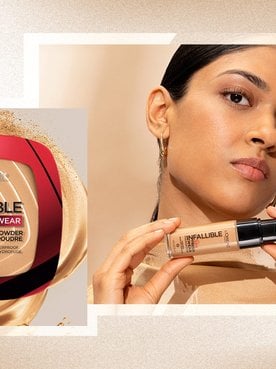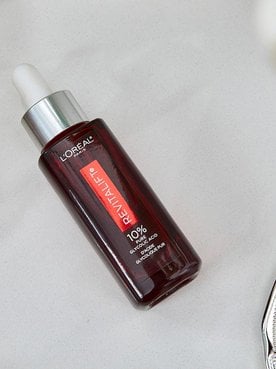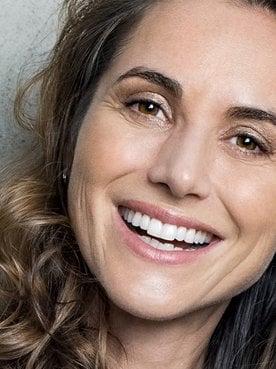Skin blemishes are one of the most common concerns people notice, whether you’re in your teens or well into adulthood. And while breakouts are usually the first thing that comes to mind, blemishes on skin can also show up as scars, dark spots, sun spots, or even melasma. Each type looks and behaves differently, so it helps to understand what blemishes are on the face and what causes them before deciding on your skincare.
Keep reading to learn what a blemish is, the most common types of facial blemishes, and the best ways to treat and prevent them. Along the way, you’ll also find dermatologist-validated L’Oréal Paris product recommendations to support your routine, making it easier to manage blemish-prone skin and keep your complexion looking healthy and radiant.
What Are Blemishes?
Simply put, a blemish is any visible mark, spot, or discoloration on the skin’s surface. While the term is often used interchangeably with acne, blemishes can also include scars, pigmentation issues, or darker patches, such as melasma. If you’ve ever wondered "what are the blemishes on my face?", it’s important to remember that blemishes on skin are completely normal and part of being human. Knowing what a blemish is and how to identify different kinds can make it easier to care for your complexion and find the right blemish treatment to reduce their appearance over time.
What Causes Skin Blemishes?
There isn’t a single cause of blemishes on the skin. They can develop due to a wide range of internal and external factors, which is why understanding triggers is so important when considering any blemish treatment. These causes explain why blemish-prone skin can look different for each person and why care routines often need to be customized. Common causes include:
- Hormonal changes: Fluctuations during puberty, menstruation, or stress can trigger oil production and breakouts, leading to different types of skin blemishes.
- Clogged pores: Dead skin cells, oil, and dirt can block pores, leading to acne blemishes that range from blackheads to pustules.
- Bacteria: When bacteria mix with clogged pores, inflammation can result, creating some of the more painful types of facial blemishes.
- Sun exposure: UV rays can lead to dark spots and sun spots, making it clear that not all blemishes on the face are acne-related.
- Genetics: Some people simply have blemish-prone skin, which can make prevention and treatment more challenging.
- Lifestyle factors: Diets high in sugar, lack of sleep, and stress can all contribute to the development of blemishes and uneven texture.
- Skincare misuse: Over-exfoliating, skipping sunscreen, or using pore-clogging products can make blemishes worse, highlighting the importance of consistent routines designed for long-term care.
Types of Skin Blemishes
There are many types of facial blemishes and skin imperfections. Understanding the difference can help you know whether you need a quick fix, long-term care, or professional treatment.
Non-inflammatory blemishes
Non-inflammatory blemishes are usually mild, not painful, and often the first type of imperfection people notice when learning what are blemishes on the face. They include clogged pores that haven’t become inflamed but can still impact overall skin texture. Recognizing these types of skin blemishes early allows you to adjust your skincare routine before they progress into more inflamed breakouts.
Blackheads
Blackheads appear as small black dots on the skin, especially around the T-zone, such as the nose, forehead, and chin. They form when a pore gets clogged with oil and dead skin, and the debris oxidizes when exposed to air, giving it a dark appearance. Though they are not usually painful, they can persist without exfoliation or the right blemish treatment, making them one of the most common types of facial blemishes.
Whiteheads
Whiteheads look like small, flesh-colored or white bumps that stay closed at the surface of the skin. Unlike blackheads, the clogged pore is sealed, keeping the buildup trapped beneath the skin and often leading to clusters of tiny spots. Whiteheads can be temporary, but if left untreated, they may often reappear, highlighting the importance of consistent exfoliation and cleansing in managing blemishes on the skin.
Inflammatory blemishes
Inflammatory blemishes are typically swollen, tender, and often red, requiring more targeted care. These types of skin blemishes can be more uncomfortable and noticeable, which is why managing them properly is important for both skin health and confidence.
Papules
According to the Cleveland Clinic, Papules are small, raised, solid bumps that don’t contain pus but can feel tender when touched. They form when excess oil, bacteria, and skin cells get trapped deeper in the skin, leading to inflamed lesions. Because these blemishes are more severe than blackheads or whiteheads, they take longer to clear and often benefit from specialized blemish treatment products or dermatological advice.
Pustules
Pustules are the classic pimples many people picture when wondering what is a blemish. They present as red bumps with a white or yellow pus-filled center caused by bacteria infecting clogged pores. While they may be common, pustules can leave marks if picked, highlighting the importance of gentle care when dealing with these types of facial blemishes.
Cysts and nodules
Cysts and nodules are the most severe acne blemishes, forming deep under the skin and often causing discomfort. Cysts are filled with pus, while nodules are harder and more inflamed, and both can result in scarring if not properly treated. Because these blemishes on skin are difficult to manage with drugstore products alone, dermatologist care is strongly recommended for effective, long-term solutions.
Post-acne marks and acne scars
After breakouts, many people notice lingering post-acne marks, red or brown discoloration that can last for weeks or months. Acne scars, however, change the skin’s texture, creating indentations or raised bumps that don’t fade as easily. These marks and scars are among the most persistent types of skin blemishes, and they often need consistent use of brightening serums, exfoliants, or professional blemish treatment to improve their appearance.
Dark spots
Dark spots are localized patches of pigmentation that may appear brown, gray, or purple depending on your skin tone. They can result from breakouts, sun exposure, or irritation, making them one of the most common types of blemishes beyond acne. Because they can last for months, they often require targeted treatments like niacinamide or glycolic acid to fade gradually.
Sun spots
Sun spots (also called age spots) are flat, brown patches that develop after long-term unprotected sun exposure. Unlike freckles, they don’t fade naturally and are often a sign of accumulated UV damage, making them one of the more stubborn types of facial blemishes. Professional treatments or brightening serums are often necessary to reduce their visibility and prevent new spots from forming.
Melasma
Melasma appears as larger, often symmetrical patches of brown or gray pigmentation on areas frequently exposed to sunlight, such as the cheeks or forehead. It is commonly triggered by hormones, pregnancy, or prolonged sun exposure, making it a challenging form of blemish-prone skin to manage. Consistent sunscreen use and brightening skincare are essential components of any blemish treatment plan for melasma, although dermatological care may be necessary in most cases.
How To Manage Skin Blemishes
There’s no single solution for blemish treatment, as different types of blemishes require different approaches. Here are some effective ways to help manage them:
Shop the Products
1. Use products with niacinamide to treat dark spots
Niacinamide, a form of vitamin B3, is one of the most researched ingredients for reducing blemishes on skin and improving tone. It helps minimize discoloration, support the skin barrier, and visibly smooth uneven texture, making it a staple for blemish-prone skin. The L’Oréal Paris Bright Reveal 12% [Niacinamide + Amino Sulfonic + Ferulic Acid] Dark Spot Serum is formulated with a high concentration of actives to fade dark spots, post-acne marks, and age spots. With regular morning and evening use, this serum works as a powerful blemish treatment, leaving the complexion brighter and more even.

2. Exfoliation for acne blemishes and skin texture
Exfoliation is crucial. By sloughing away dead skin cells, you reduce the chances of clogged pores and reveal fresher-looking skin beneath. The L’Oréal Paris RevitaLift 10% Pure Glycolic Acid Serum is a dermatologist-validated resurfacing formula that provides daily gentle exfoliation to visibly even skin tone, smooth fine lines, and reduce dark spots. Glycolic acid helps resurface skin so it looks brighter, smoother, and more refined, while added aloe helps soothe and comfort blemish-prone skin. With consistent use, this serum supports long-term skin clarity and radiance.
For more advanced care, try the L’Oréal Paris Bright Reveal Dark Spot Exfoliant Peel. This exfoliating solution visibly reduces post-acne marks, renews skin tone and texture, and brightens the complexion. Its unique blend of acids, inspired by professional peels, works to fade all types of dark spots, smooth roughness, and refresh the look of blemish-prone skin. After one use, skin looks brighter and feels softer; with consistent use up to four times per week at night, you’ll notice a more even tone, refined texture, and fewer stubborn facial blemishes.

3. Hands off: why you shouldn’t pick pimples
It can be tempting to pick at blemishes, but doing so often leads to irritation, post-acne marks, and sometimes scars. Touching inflamed spots can spread bacteria and worsen blemishes, such as pustules or papules. To avoid this, rely on hydrocolloid patches or spot treatments that shield the blemish and encourage faster healing without the risk of permanent marks. This simple habit helps support healthier-looking skin and prevents new types of facial blemishes from forming.
4. Be patient: how long do blemish treatments take to work
If you’re wondering how quickly blemishes disappear, the reality is that even the most effective products take time to deliver visible results. Dermatologists recommend giving new blemish treatments at least four to six weeks of consistent use. Spot treatments may shrink a pimple overnight, but fading post-acne marks or dark spots usually requires patience and long-term commitment to your skincare routine.
5. When to see a dermatologist for blemishes
Some types of facial blemishes, like cysts, nodules, or persistent scars, require more than over-the-counter care. If you’ve tried serums, cleansers, and topical products without success, a dermatologist can provide targeted solutions. They may suggest prescription creams, in-office chemical peels, or laser therapy for stubborn blemishes on the face or body that don’t respond to regular products. Consulting an expert ensures you get a tailored plan for clearer, healthier skin.
6. Over-the-counter vs. professional treatments
Over-the-counter options can deliver visible improvements for mild blemishes. These are excellent for managing everyday acne blemishes, dark spots, and uneven texture. For more severe types of skin blemishes, dermatologists may recommend stronger prescription topicals, micro-needling, or laser treatments to achieve lasting results. Choosing between these approaches depends on the severity of your condition and your skincare goals, but both play an important role in comprehensive blemish treatment.
How To Prevent Blemishes
While treatments can reduce facial blemishes, prevention is just as important. Incorporating these habits into your routine can help keep skin clear and balanced.
1. Daily cleansing to prevent blemishes
Cleansing is one of the most important steps in preventing blemishes and keeping skin balanced. Washing your face in the morning and at night helps remove excess oil, dirt, and makeup that could otherwise clog pores and lead to acne blemishes. The L’Oréal Paris RevitaLift Radiant Smoothing Cream Cleanser is a gentle option that exfoliates with vitamin C while enhancing radiance, making it an ideal first step for anyone dealing with blemish-prone skin.
2. Retinol for blemish-prone skin
When it comes to long-term care for types of facial blemishes, retinolis one of the most effective ingredients. It encourages cell turnover, helping to unclog pores and smooth uneven texture, while also addressing early signs of discoloration that may appear after acne heals. The L’Oréal Paris RevitaLift Night Serum, 0.3% Pure Retinol offers a lightweight formula that refines skin tone and minimizes the appearance of blemishes on the skin. Begin with one or two applications per week, gradually increasing frequency as your skin builds tolerance.
Shop the Products
3. Hydration and non-comedogenic moisturizers
Even if you struggle with oily or blemish-prone skin, hydration is essential. Skipping moisturizer can dehydrate the skin, which may trigger excess oil production and more facial blemishes. Look for non-comedogenic, water-based moisturizers to keep your skin hydrated without clogging pores.
Try the L'Oréal Paris RevitaLift Micro Hyaluronic Acid + Ceramides Line-Plumping Water Cream. This lightweight face moisturizer deeply hydrates and visibly replumps all types of fine lines. It's a non-greasy, quickly absorbing formula that will help restore balance and support your blemish treatment.
4. Sunscreen to prevent dark spots and post-acne marks

Daily sun protection is key when learning about blemishes and how to manage them, because UV rays can darken post-acne marks and create new types of skin blemishes like sun spots. The L’Oréal Paris RevitaLift Triple Power Moisturizer with SPF 30 provides both hydration and broad-spectrum protection, making it easier to defend your skin against future blemishes. Reapplying sunscreen every two hours ensures ongoing protection and supports clearer-looking skin.
Shop the Products
5. Lifestyle habits that help prevent blemishes
Healthy habits can make a visible difference in reducing blemishes over time, especially when paired with a consistent skincare routine. Simple everyday choices add up and make it easier to manage blemish-prone skin and reduce the chance of new breakouts. Here are a few key habits to keep in mind:
- Balanced diet: Eat plenty of fruits, vegetables, and whole foods to support your skin from the inside out and lower the likelihood of breakout blemishes.
- Consistent sleep: Prioritize quality rest so your skin has time to repair itself overnight.
- Stress management: Incorporate exercise, journaling, meditation, or other calming activities to help minimize hormonal triggers that can cause blemishes on your skin.
- Routine care: Stick to cleansing, hydrating, and protecting your skin daily to keep it healthy and resilient.
These lifestyle adjustments, combined with your regular skincare routine, create a stronger foundation for keeping different types of skin blemishes under control and maintaining a radiant, even-looking complexion.
Next Up: How To Get Clear Skin: 12 Tips for a Clearer Complexion
Photo courtesy of L’Oréal Paris







